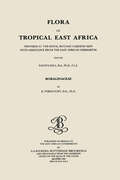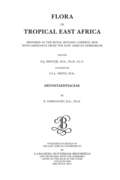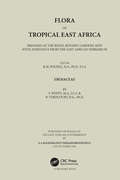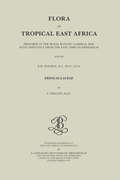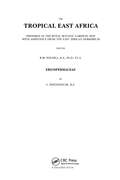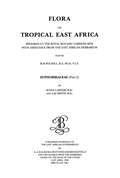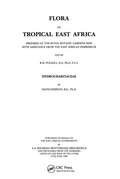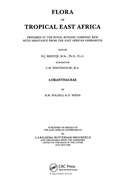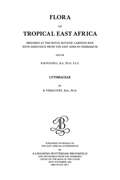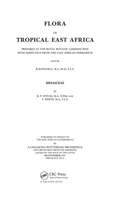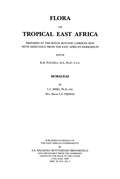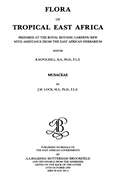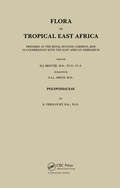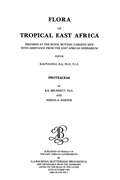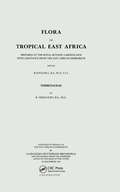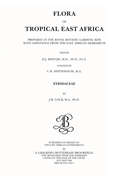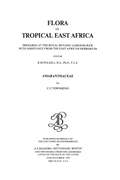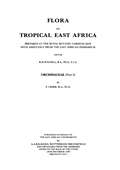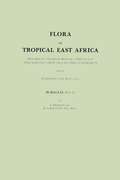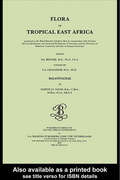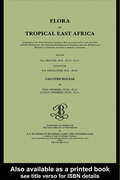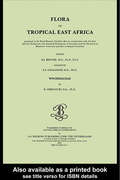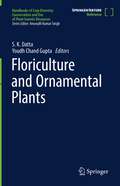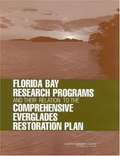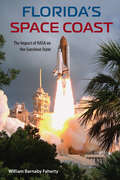- Table View
- List View
Flora of Tropical East Africa - Boraginaceae (1991)
by Bernard VerdcourtThe Flora of Tropical East Africa prepared at the Royal Botanic Gardens/Kew with the assistance from the East African Herbarium. A volume looking at the considerable family of around 2000 species (three-quarters herbs and subshrubs and the rest trees and shrubs).
Flora of Tropical East Africa - Dennstaetiacea (2000)
by Bernard VerdcourtThe flora is prepared at Royal Botanic Gardens, Kew, in close collaboration with East African Herbarium and in liaison with the University of Dar es Salaam, the University of Nairobi and the Makerere University. Significant contributions are also made by specialists elsewhere. The flora is designed to a high academic standard and should be a useful resource reference for anyone concerned with the identification and utilization of plants in eastern Africa. Each family is published as a separate part.
Flora of Tropical East Africa - Ebenaceae (1996)
by B Verdcourt F WhitePart of a series of volumes on the flora of tropical East Africa, this text covers the Ebenaceae family.
Flora of Tropical East Africa - Eriocaulaceae (1997)
by Sylvia PhillipsThe Flora is prepared at the Royal Botanic Gardens, Kew in close collaboration with East African Herbarium and in liaison with the University of Dar es Salaam, the University of Nairobi and the Makerere University. Significant contributions are also made by specialists elsewhere. This reference should be of use to anyone concerned with the identification and utilization of plants in eastern Africa.
Flora of Tropical East Africa - Eriospermaceae (1996)
by C. WhitehousePart of a series of volumes on the flora of tropical East Africa, this text covers the Eriospermaceae family.
Flora of Tropical East Africa - Euphorbiac v2 (1988)
by Susan Carter A. R. SmithThis volume focuses on the family Euphorbiaceae. They are well defined tribe which includes ten other small genera of tropical and sub-tropical regions. Euphorbia are annual, biennial or perennial herbs, shrubs or trees, sometimes succulent and unarmed or spiny, with a milky usually caustic latex.
Flora of Tropical East Africa - Hydrocharitaceae (1989)
by R.M. PolhillThis book is a comprehensive review of the genera of Hydrocharitaceae, a flowering plant family, found in tropical East Africa. It presents information on their character, occurrence, habitat, phenotypic variations and distribution of each of the species under these genera.
Flora of Tropical East Africa - Loranthaceae (1999)
by H.J. BEENTJE, M.Sc., Ph.D., F.L.S.; C.M. WHITEHOUSE, M.A.; R.M. POLHILL; D. WIENSThe flora is prepared at Royal Botanic Gardens, Kew, in close collaboration with East African Herbarium and in liaison with the University of Dar es Salaam, the University of Nairobi and the Makerere University. Significant contributions are also made by specialists elsewhere. The flora is designed to a high academic standard and should be a useful resource reference for anyone concerned with the identification and utilization of plants in eastern Africa. Each family is published as a separate part.
Flora of Tropical East Africa - Lythraceae (1994)
by B. VerdcourtThis book is a comprehensive review of the genera of Lythraceae, a flowering plant family of mostly trees and shrubs, found in tropical East Africa. It presents information on their character, occurrence, habitat, phenotypic variations and distribution of each of the species under these genera.
Flora of Tropical East Africa - Meliaceae (1991)
by Frank White Brian Thomas StylesThis book is a comprehensive review of the genera of Meliaceae, a flowering plant family of mostly trees and shrubs, found in tropical East Africa. It presents information on their character, occurrence, habitat, phenotypic variations and distribution of each of the species under these genera.
Flora of Tropical East Africa - Moraceae (1989)
by R.M. POLHILL, B.A., Ph.D., F.L.S.; C.C. BERG, Ph.D.; Mrs. Maria E.E. HIJMANThis book is a comprehensive review of the genera of Moraceae, a family of flowering plants, found in the tropical region of East Africa. It presents information on their character, occurrence, habitat, phenotypic variations and distribution of each of the species under these genera.
Flora of Tropical East Africa - Musaceae (1993)
by J.M. LockPart of a series on the flora of tropical East Africa, this work considers Musaceae. The flora is prepared at Royal Botanic Gardens, Kew in close collaboration with East African Herbarium and in liaison with the University of Dar es Salaam, the University of Nairobi and the Makerere University. Significant contributions are also made by specialists from elsewhere. The flora should be a useful reference for anyone concerned with the identification and utilization of plants in eastern Africa. Each family is published as a separate part. New parts are published annually. All back volumes are also available.
Flora of Tropical East Africa - Polypodiaceae (2001)
by Bernard VerdcourtPart of a series on the flora of tropical East Africa, this work considers Polypodiaceae. The flora is prepared at Royal Botanic Gardens, Kew in close collaboration with East African Herbarium and in liaison with the University of Dar es Salaam, the University of Nairobi and the Makerere University. Significant contributions are also made by specialists from elsewhere. The flora should be a useful reference for anyone concerned with the identification and utilization of plants in eastern Africa. Each family is published as a separate part. New parts are published annually.
Flora of Tropical East Africa - Proteaceae (1993)
by R. K. Brummitt Serena K. MarnerPart of a series on the flora of tropical East Africa, this work considers Proteaceae. The flora is prepared at Royal Botanic Gardens, Kew in close collaboration with East African Herbarium and in liaison with the University of Dar es Salaam, the University of Nairobi and the Makerere University. Significant contributions are also made by specialists from elsewhere. The flora should be a useful reference for anyone concerned with the identification and utilization of plants in eastern Africa. Each family is published as a separate part. New parts are published annually. All back volumes are also available.
Flora of Tropical East Africa - Verbenaceae (1992)
by B VerdcourtThis book is a comprehensive review of the genera of Verbenaceae, a flowering plant family, found in tropical East Africa. It presents information on their character, occurrence, habitat, phenotypic variations and distribution of each of the species under these genera.
Flora of Tropical East Africa - Xyridaceae (1999)
by J. M. LockThe flora is prepared at Royal Botanic Gardens, Kew, in close collaboration with East African Herbarium and in liaison with the University of Dar es Salaam, the University of Nairobi and the Makerere University. Significant contributions are also made by specialists elsewhere. The flora is designed to a high academic standard and should be a useful resource reference for anyone concerned with the identification and utilization of plants in eastern Africa. Each family is published as a separate part.
Flora of Tropical East Africa -Amaranthaceae (1985)
by C. C. TownsendThis volume focuses on the family Amaranthaceae. They are annual or perennial herbs or subshrubs, rarely lianes and large and mainly tropical family of some 65 genera and over 1000 species, including many cosmopolitan weeds and a large number of xerophytic plants.
Flora of Tropical East Africa: Orchidaceae (Part 3) (Flora Of Tropical East Africa Ser.)
by P. CribbFirst published in 1989. CRC Press is an imprint of Taylor & Francis.
Flora of Tropical East Africa: Prepared at the Royal Botanic Gardens/Kew With Assistance from the East African Herbarium
by D. BrisdonThe Rubiaceae are a family of flowering plants, commonly known as the coffee, madder, or bedstraw family. This volume was prepared at the Royal Botanic Gardens, Kew with assistance from the East Africain Herbarium. It contains a synopsis of subfamilies and tribe; as well as labelled diagrams.
Flora of tropical East Africa - Balanitaceae (2003)
by H. J. Beentje S. A. GhazanfarPrepared at the Royal Botanic Gardens, Kew, in close collaboration with the East African Herbarium and in liaison with the University of Dar es Salaam, the University of Nairobi and the Makerere University, this series is designed to the highest academic standards and is a useful reference for anyone concerned with the identification and utilizatio
Flora of tropical East Africa - Callitrichaceae (2003)
by H. J. Beentje S. A. GhazanfarPrepared at the Royal Botanic Gardens, Kew, in close collaboration with the East African Herbarium and in liaison with the University of Dar es Salaam, the University of Nairobi and the Makerere University, this series is designed to the highest academic standards and is a useful reference for anyone concerned with the identification and utilizatio
Flora of tropical East Africa - Woodsiaceae (2003)
by B. Verdcourt H. J. Beentje S. A. GhazanfarPrepared at the Royal Botanic Gardens, Kew, in close collaboration with the East African Herbarium and in liaison with the University of Dar es Salaam, the University of Nairobi and the Makerere University, this series is designed to the highest academic standards and is a useful reference for anyone concerned with the identification and utilizatio
Floriculture and Ornamental Plants (Handbooks of Crop Diversity: Conservation and Use of Plant Genetic Resources)
by S. K. Datta Youdh Chand GuptaThe volume on oilseed crops is developed as a part of a series on “Handbook of Agrobiodiversity: Conservation and Use of Plant Genetic Resources”. The handbook would function as a ready reference book for availability of PGR globally, along with specific source, wherefrom they can be procured, and used breeding programs, particularly to overcome various crop production constraints and to improve productivity and quality. The volume on floriculture and ornamental plants will be the source of basic information on origin and evolution and global dispersal of cultivated species of ornamentals. Presently, floriculture has established its credibility in improving income through increased productivity, generating employment and in enhancing exports. All research and developmental activities on ornamental crops are essentially multi-disciplinary in nature recognizing local issues as well as country issue. Floriculture is developing as an area of high technology based frontier interdisciplinary area on scientific excellence. Floriculture has progressed both scientifically and commercially due to concentrated efforts made on multidisciplinary research. It is developing as an area of high technology based frontier interdisciplinary area on scientific excellence. The volume will contain all information about different ornamentals. This shall be put together to develop a complete documentation of the results of the research and demonstrations conducted by different scientists. The volume will provide an illustrated horto-taxonomical account of important ornamental species and cultivars, germplasm status and their usages, propagation, nursery management, techno-economics, conventional breeding, induced mutagenesis, new varieties, cytogenetics, tissue culture, characterization of varieties, dehydration of flowers etc. This volume will give a coherent and concise account on recent developments. It will deal with all the important and relevant aspects of floriculture. The publication of this volume is planned to reveal multifarious activities done on different aspects of floriculture so that innovations made so far can be used judiciously for this sector. This book shall provide authoritative review account of many aspects of current interest and progress in the field of floriculture. The topics included in the book are interdisciplinary and cater not only classical floriculture but also relevant modern aspects. The book will provide valuable data on different aspects and will be widely accepted by by professional scientists, researchers, teachers, students, floriculturists, technocrats and planners. The volume will be an invaluable asset to floriculture scientists.
Florida Bay Research Programs And Their Relation To The Comprehensive Everglades Restoration Plan
by Committee on Restoration of the Greater Everglades EcosystemThe National Academies Press (NAP)--publisher for the National Academies--publishes more than 200 books a year offering the most authoritative views, definitive information, and groundbreaking recommendations on a wide range of topics in science, engineering, and health. Our books are unique in that they are authored by the nation's leading experts in every scientific field.
Florida's Space Coast: The Impact of NASA on the Sunshine State (Florida History and Culture)
by William B. Faherty"An important, interesting study of the relations between the Kennedy Space Center and the communities of Brevard County, Florida."--Roger D. Launius, chief historian, NASA, Washington, D.C."This outstanding book provides readers of Florida history our first insight into the impact that high technology has had on the state. Brevard County is a veritable laboratory for understanding what happens when space science and engineering put down roots in a wilderness setting. Faherty's writing is direct, simple, even folksy at times. I devoured it!"--Michael Gannon, author of Pearl Harbor Betrayed and A Short History of FloridaFlorida&’s Space Coast tells the compelling story of America's half century in space exploration, from the successful launch of the first two-stage rocket in 1950 through the latest space shuttle missions of 2000. Told from the unique viewpoint of the people who built the Spaceport, this book shows how the space program transformed the east central Florida coast from a traditional citrus production and tourist area to one of the most influential high-tech centers in the nation.Cape Canaveral was chosen as a missile launch site because of its many geographical advantages. However, in the early years of the space program, the area was far from an ideal place for NASA employees to raise their families. NASA brought in thousands of space-related workers, who, besides sending machines and men into space, had to meet the challenge of moving their families from urban environs to a rural southern county. This book engagingly recounts the parallel stories of the establishment of America's space program and its impact on the development of Brevard County.William Barnaby Faherty is professor emeritus of history at St. Louis University and director of the Museum of the Western Jesuit Missions in Hazelwood, Missouri.
